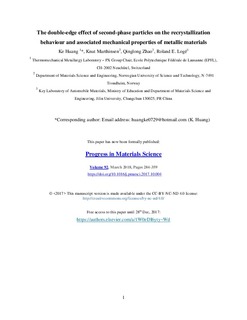| dc.contributor.author | Huang, Ke | |
| dc.contributor.author | Marthinsen, Knut | |
| dc.contributor.author | Zhao, Qinglong | |
| dc.contributor.author | Loge, Roland E. | |
| dc.date.accessioned | 2019-02-21T08:59:56Z | |
| dc.date.available | 2019-02-21T08:59:56Z | |
| dc.date.created | 2018-11-25T13:15:55Z | |
| dc.date.issued | 2018 | |
| dc.identifier.citation | Progress in Materials Science. 2018, 92 284-359. | nb_NO |
| dc.identifier.issn | 0079-6425 | |
| dc.identifier.uri | http://hdl.handle.net/11250/2586647 | |
| dc.description.abstract | Most industrial alloys contain a matrix phase and dispersed second-phase particles. Several thermomechanical processing (TMP) steps are usually needed to produce a final product, during which recrystallization and its related phenomena may take place. Second-phase particles may retard or accelerate recrystallization, depending on their size and spatial distribution, the TMP conditions, among others. Besides their effect on recrystallization kinetics, the introduction of second-phase particles creates additional interfaces within the matrix, it also modifies the grain structure and crystallographic texture after recrystallization, which then either improves or deteriorates the associated mechanical properties of the investigated materials. The interactions between second-phase particles and recrystallization are further complicated when these particles are not stable. In addition to particle coarsening, they can also precipitate out or dissolve into the matrix before, simultaneously with or after recrystallization. This review article attempts to summarize the recent progresses on the complex interaction between second-phase particles and recrystallization and the science behind them. This double-edge effect of second-phase particles on recrystallization behaviour and mechanical properties of metallic materials is still far from being clear. A better understanding of this issue is of high academic and industrial interests, since it provides potential freedom for TMP design and microstructure control. | nb_NO |
| dc.language.iso | eng | nb_NO |
| dc.publisher | Elsevier | nb_NO |
| dc.rights | Attribution-NonCommercial-NoDerivatives 4.0 Internasjonal | * |
| dc.rights.uri | http://creativecommons.org/licenses/by-nc-nd/4.0/deed.no | * |
| dc.title | The double-edge effect of second-phase particles on the recrystallization behaviour and associated mechanical properties of metallic materials | nb_NO |
| dc.type | Journal article | nb_NO |
| dc.type | Peer reviewed | nb_NO |
| dc.description.version | acceptedVersion | nb_NO |
| dc.source.pagenumber | 284-359 | nb_NO |
| dc.source.volume | 92 | nb_NO |
| dc.source.journal | Progress in Materials Science | nb_NO |
| dc.identifier.doi | 10.1016/j.pmatsci.2017.10.004 | |
| dc.identifier.cristin | 1634637 | |
| dc.description.localcode | © 2017. This is the authors’ accepted and refereed manuscript to the article. Locked until 27.10.2019 due to copyright restrictions. This manuscript version is made available under the CC-BY-NC-ND 4.0 license http://creativecommons.org/licenses/by-nc-nd/4.0/ | nb_NO |
| cristin.unitcode | 194,66,35,0 | |
| cristin.unitname | Institutt for materialteknologi | |
| cristin.ispublished | true | |
| cristin.fulltext | postprint | |
| cristin.qualitycode | 2 | |

